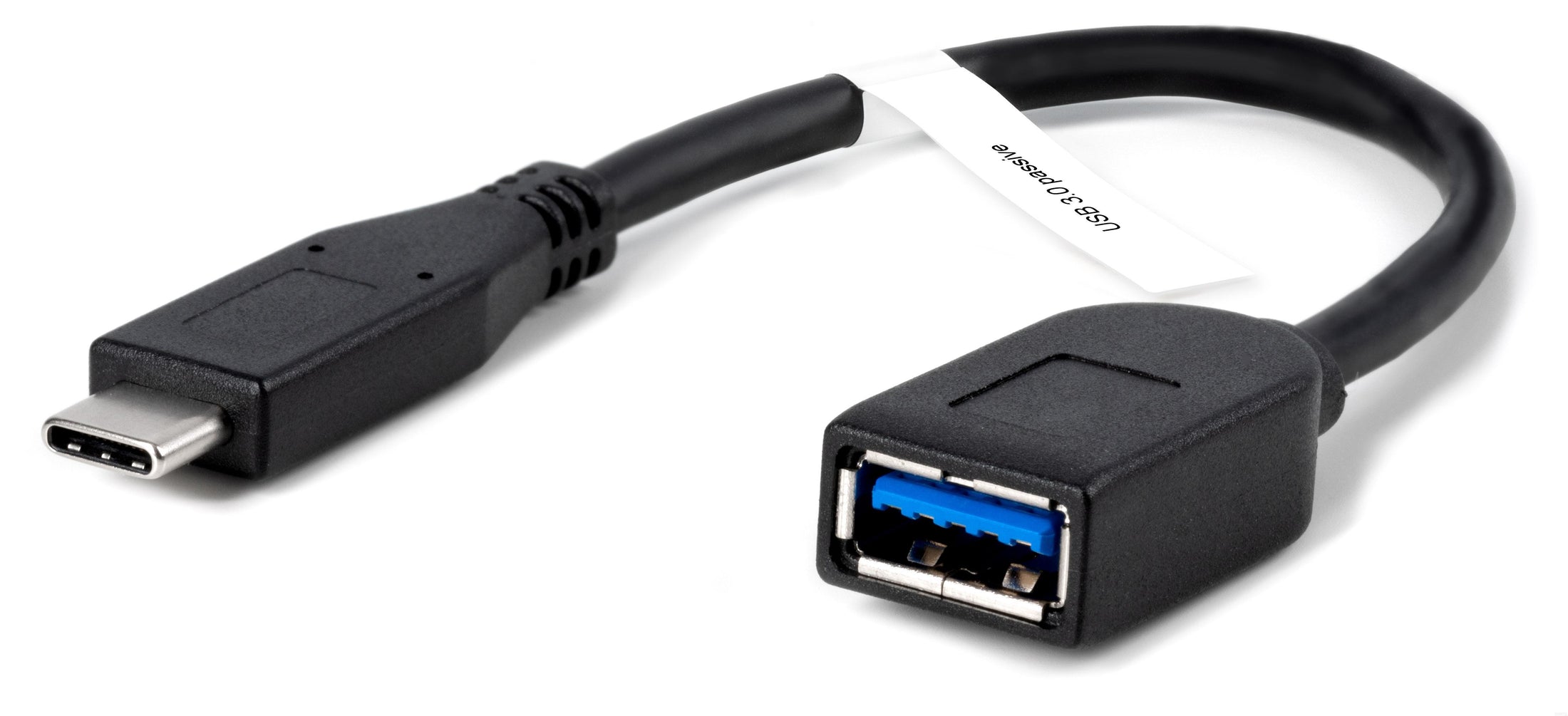
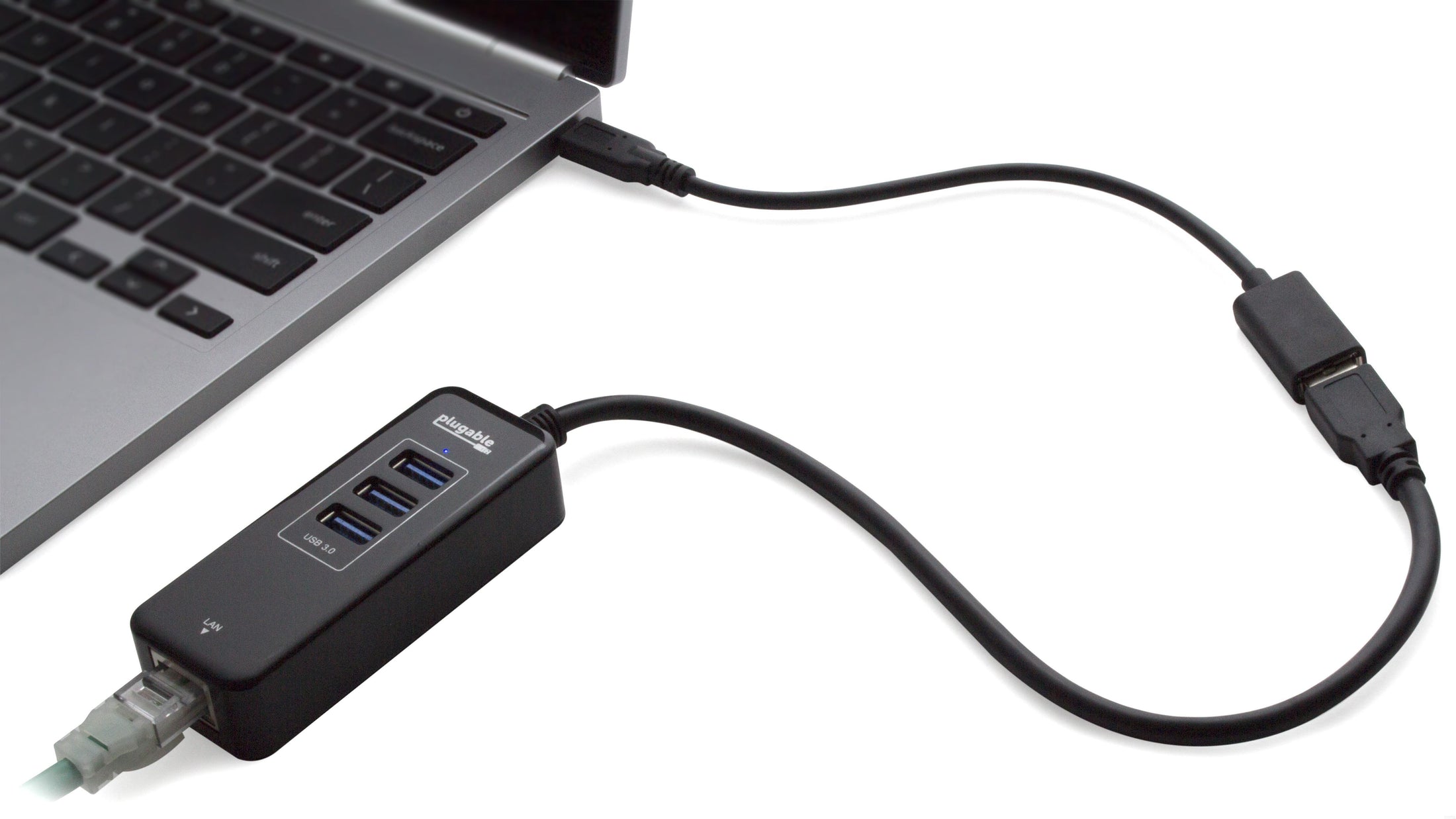
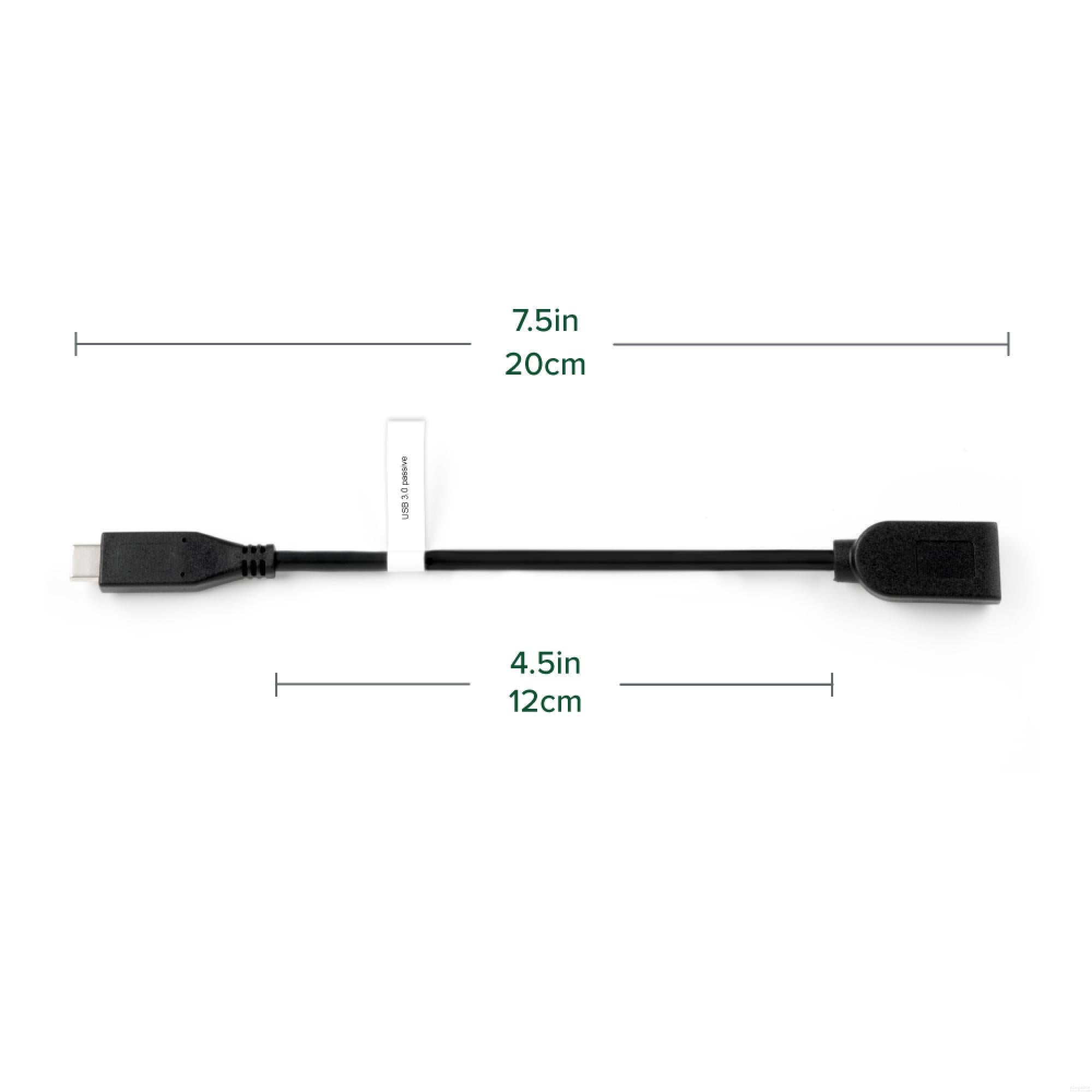

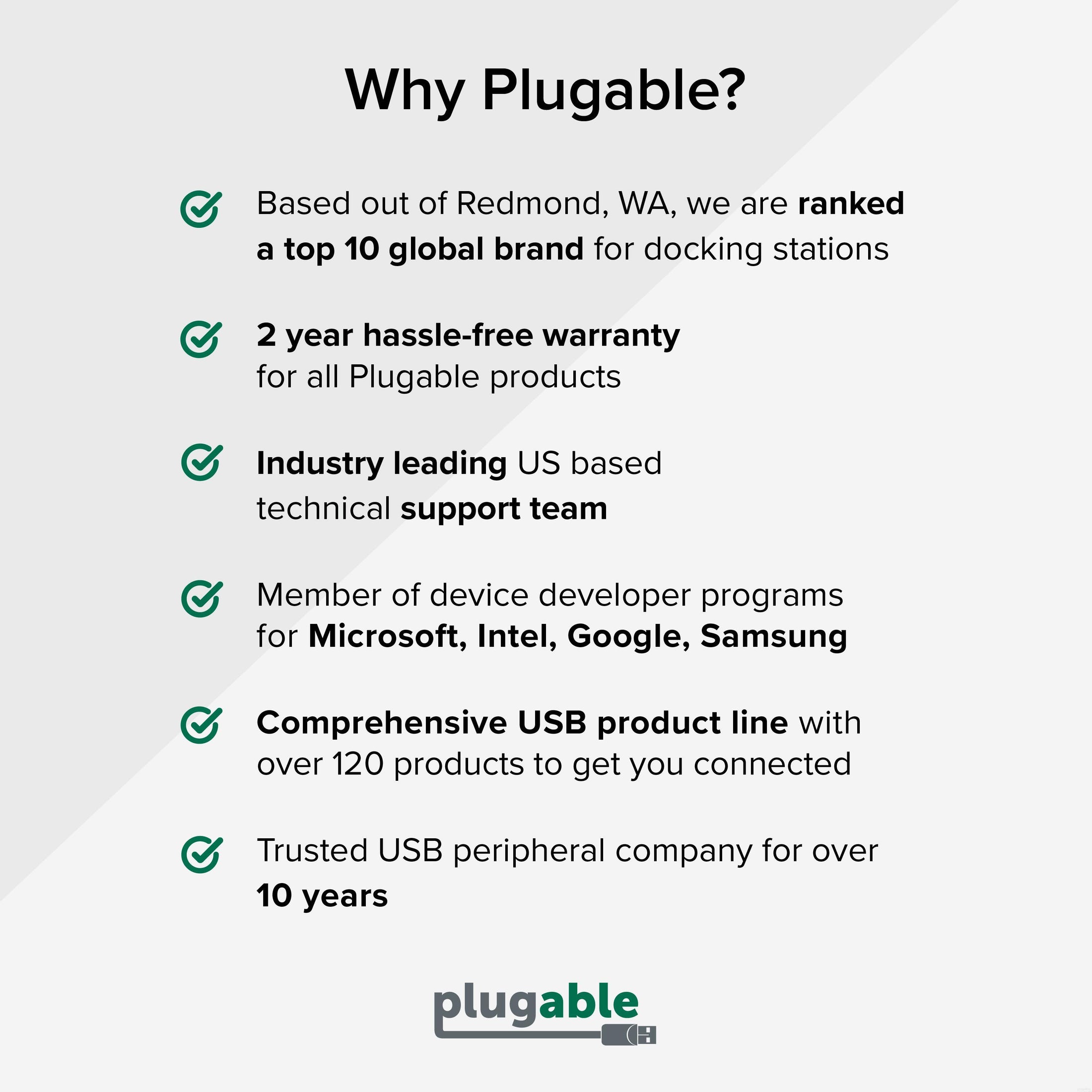





Plugable USB 3.0 Passive Type-A to Type-C Cable (6in/15cm)
$7.95 USD
SKU: USBC-AF3Amazon Rating : (337 Reviews)
Features
- Universal Compatibility—Connect any USB C, USB4, Thunderbolt 3, or Thunderbolt 4 enabled laptop, phone, or tablet to a legacy USB 3.0 device or peripheral (flash drives, keyboards, mice)
- User Friendly—Plug-and-play USB to USB C adapter for home or office use, 20cm cable designed to fit side-by-side on laptops with two neighboring USB C ports. This also works well as a USB connection to phone adapter.
- Performance—This Plugable USB to USBC adapter cable allows for transfer speeds up to 5Gbps, backwards compatibility, syncing, and charging.
- Compatible With—MacBooks, most Windows systems with Windows 10 or newer, and most Chromebooks running ChromeOS 100 or newer that has a USB C port. Macbook Pro 13" / 14" / 15", 16", MacBook Air, MacBook Retina, MacBook M1 / M2 / M3, HP Spectre x360 / Pavilion / Envy, Dell XPS / Precision / Latitude, Lenovo ThinkPad / IdeaPad / Yoga / Flex, Surface Pro 7 / 7+ / 8 / 9, Surface Laptop 3 / 4 / 5 / Studio / SE, Surface Go / Go 2 / Go 3, LG Gram, Acer Aspire / Swift / Spin, ASUS Zenbook / Vivobook
- 2 Year Warranty—We love our Plugable products, and hope you will too. All of our products are backed with a 2-year limited parts and labor warranty as well as Seattle-based email support
Plugable USB-C to USB 3.0 Adapter Cable
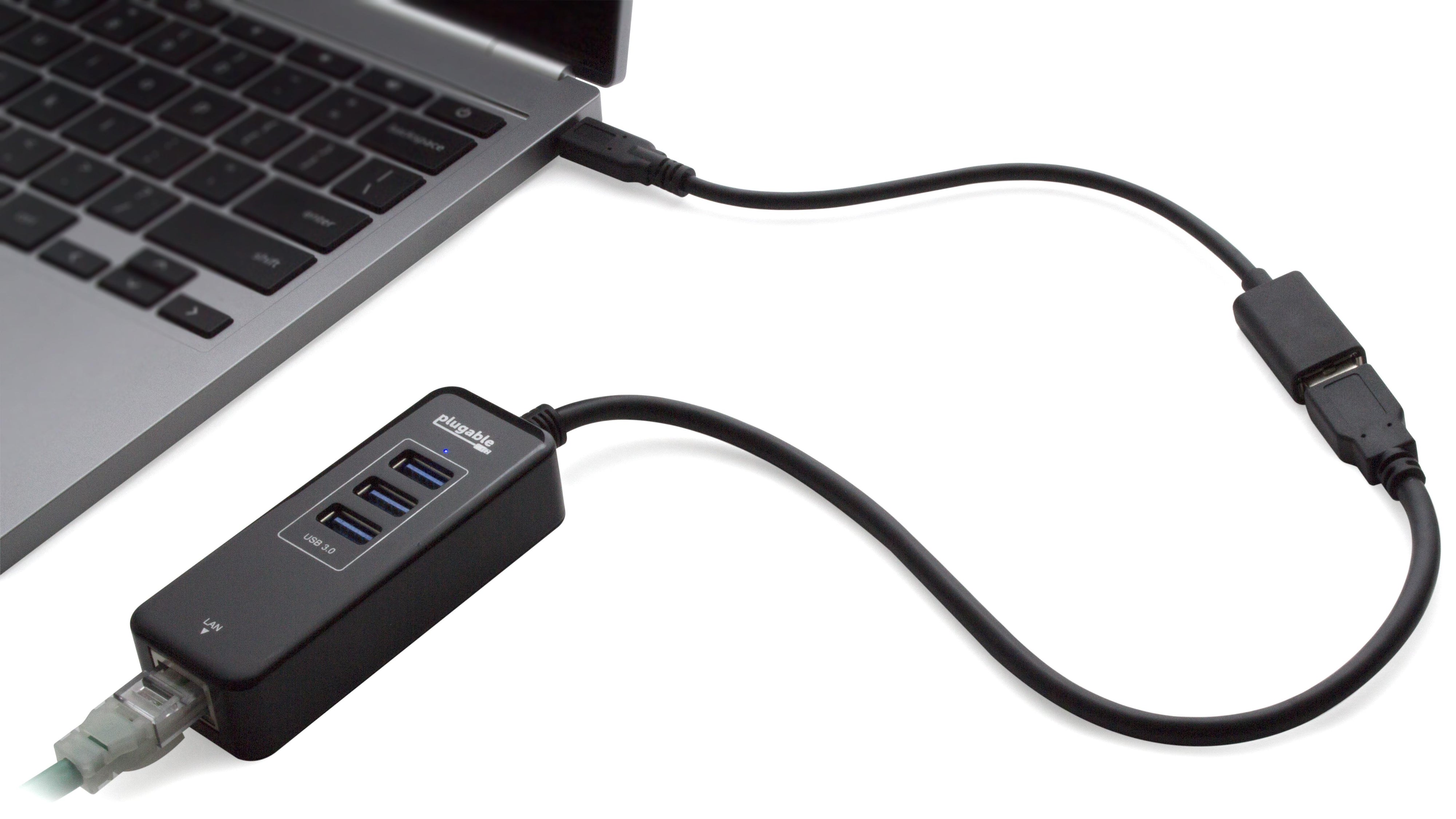
Connect Legacy USB 3.0 Devices to a New USB-C (USB Type-C) and Thunderbolt 3 Enabled Systems
Through our Male USB-C to Female USB 3.0 Cable (USBC-AF3), you can plug almost any legacy USB 1.1, 2.0, or 3.0 device you own into your new USB-C or Thunderbolt 3 equipped laptop, tablet, or phone.
Since this cable is a passive adapter and is short in length, its functionality prevents signal interference and timing issues associated with active cables. Adapter cable features clean shielding and is completely plug and play. (Though please note devices connected to the adapter will require drivers as normal.)
As a USB 3.0 cable, our USB-C to female Type-A cable supports up to 5Gbps SuperSpeed transfers for USB 3.0 devices, with backwards compatibility for USB 1.1 and 2.0 devices. USB 3.0 adapters like this one are also known as USB 3.1 Gen 1 or USB 3.2 Gen 1. In terms of functionality, it offers the same throughput as USB 3.0 with transfer speeds up to 5Gbps, and does not support USB PD (Power Delivery).
Note 1: Phones and non-Windows tablets with USB-C may not have the necessary drivers or power for attached legacy USB devices.
Note 2: Not a USB PD (Power Delivery) cable. Please note that smartphones and tablets may not deliver power through this cable.
FAQ
Can I use this cable to connect my old USB 3.0 Hub to my new PC with USB Type-C ports?
Yes, this USBC-AF3 cable supports USB 3.0. You should be able to connect your legacy USB 3.0 HUB as same as before by using this adapter cable.
Can I use this cable to charge my new smart phone with an USB-C port?
This cable does not support any special functionality for charging. It is not recommended to use this adapter cable for charging.I connected my USB Ethernet adapter to my smartphone by using this USBC-AF3 adapter cable, but it cannot connect to the network. Why is that?
It is possible that your phone does not support the USB Ethernet adapter. This means that the device driver for the USB Ethernet adapter has not been installed into your phone, or not activated, or has some other problem. In order to make any USB devices work by using this USBC-AF3 adapter, the proper device driver for the USB device must be running in the system.
In The Box
| Item and Quantity | Item Notes |
|---|---|
| 1x USB 3.0 Type-A to C cable |
Included Cables
| Port Type (Side 1) | Cable Specification | Port Type (Side 2) | Cable Length | External Power for Cable |
|---|---|---|---|---|
| Male USB-C | USB 3.0 (5Gbps) | USB-A | 0.2m/0.66ft | No |
USB To Devices
| Port | Placement | Version and Link Rate | Features | Voltage | Amperage | Wattage |
|---|---|---|---|---|---|---|
| 1x USB-A | Cable End | USB 3.0 (5Gbps) | 5V | 900mA | 4.5W |
Connection To Host
| Port | Placement | Version and Link Rate | Features |
|---|---|---|---|
| 1x USB-C | Cable End | USB 3.0 (5Gbps) |
Physical Stats
| Item | Size (H x W x D) or Length | Weight | SKU or Part Number |
|---|---|---|---|
| USB C to Type-A adapter | 0.2 meters 0.7 feet |
20 grams 0.7 ounces |
USBC-AF3 |
Get Started
- Connect the USB-C plug into your laptop, phone, tablet, or USB-C peripheral.
- Plug in a USB-A plug or cable into the socket end of the adapter cable.
Filter Help Articles and Frequent Questions by Category
Choose one or more filters within each category to narrow down the articles. Each selection will result in only displaying articles that include all of your choices.
Articles
Well how about that, it looks like we don't have any articles matching your filters! Try removing one of your choices or clear the filters to show all articles.
You can always contact support if you need help too!
USB Port Types
USB-A
pietz, CC BY-SA 3.0 , via Wikimedia Commons
This is the standard USB connection that most computers offered prior to the introduction of USB Type-C (USB-C). Even after the introduction of USB Type-C, this is still quite common.
It can provide data transfer rates up to the USB 3.1 Gen 2 (10 gbps) specification depending on the host and device, but does not directly support video in the way that USB-C Alternate Mode does. This limitation makes DisplayLink USB graphics adapters and docking stations ideal on systems that do not have USB-C, or in instances where more displays are needed beyond available video outputs of a PC.
USB-B
Fred the Oyster, CC BY-SA 4.0 , via Wikimedia Commons
IngenieroLoco, CC BY-SA 4.0, via Wikimedia Commons
This type of connection comes in a couple different styles depending on whether USB 3.0 and higher transfer rates are supported (bottom graphic). Usually this type of connection is used to plug into USB devices that do not have a fixed cable connected, such as USB docking stations, USB hubs, printers, and others.
USB Mini-B
Fred the Oyster, CC BY-SA 4.0 , via Wikimedia Commons
One of the first connectors for charging a smartphone, wireless game controller (such as the Sixaxis and DualShock 3), and other small devices such as external hard drives. Not commonly used today, but is still used in some cases. Most devices using USB Mini B are using USB 2.0, though a USB 3.0 variant does exist. This specification also added USB On-The-Go (OTG) functionality, though it is more commonly implemented with Micro USB.
USB Micro-B
Fred the Oyster, CC BY-SA 4.0, via Wikimedia Commons
IngenieroLoco, CC BY-SA 4.0 , via Wikimedia Commons
A smaller connector that serves many of the same uses as the Mini B connector, with added optional features such as Mobile High-Definition Link (MHL) to allow devices like smartphones to output video to larger displays without requiring a dedicated port for video output.
The larger variant of USB-B is most commonly used for external hard drives for higher 5Gbps transfer rates.
USB-C, Thunderbolt™ 3, and Thunderbolt™ 4
Niridya , CC0, via Wikimedia Commons
The most recent USB connection, USB Type-C (USB-C), represents a major change in what USB can do. The connector is smaller, can be connected in two orientations, is able to carry substantially more power and data, and can directly carry video signals of multiple types (HDMI, DisplayPort, etc.) Intel has also adapted the USB-C connector for use with Thunderbolt 3 and Thunderbolt 4.
It is important to note that while all Thunderbolt 3 and Thunderbolt 4 connections are USB-C, not all USB-C connections can be used with Thunderbolt 3 or Thunderbolt 4 devices.
More details regarding physical USB connections can be found on Wikipedia . The graphics depicted here are adapted from Wikimedia Commons by various artists under the Creative Commons Attribution-Share Alike 3.0 Unported license.
Do Plugable products support the Apple SuperDrive?
Unfortunately Plugable products do not support the Apple SuperDrive.
The Apple SuperDrive has stringent power requirements that can only be met by directly connecting the SuperDrive to your host laptop. As a result at this time Apple recommends only using their USB-C adapter cables. You can find more information on that here → How to connect the Apple USB SuperDrive
If you have purchased a Plugable product to use with your Apple SuperDrive, and would like some additional assistance please do not hesitate to reach out. You can do so by emailing support@plugable.com, or going to Plugable.com/Support.